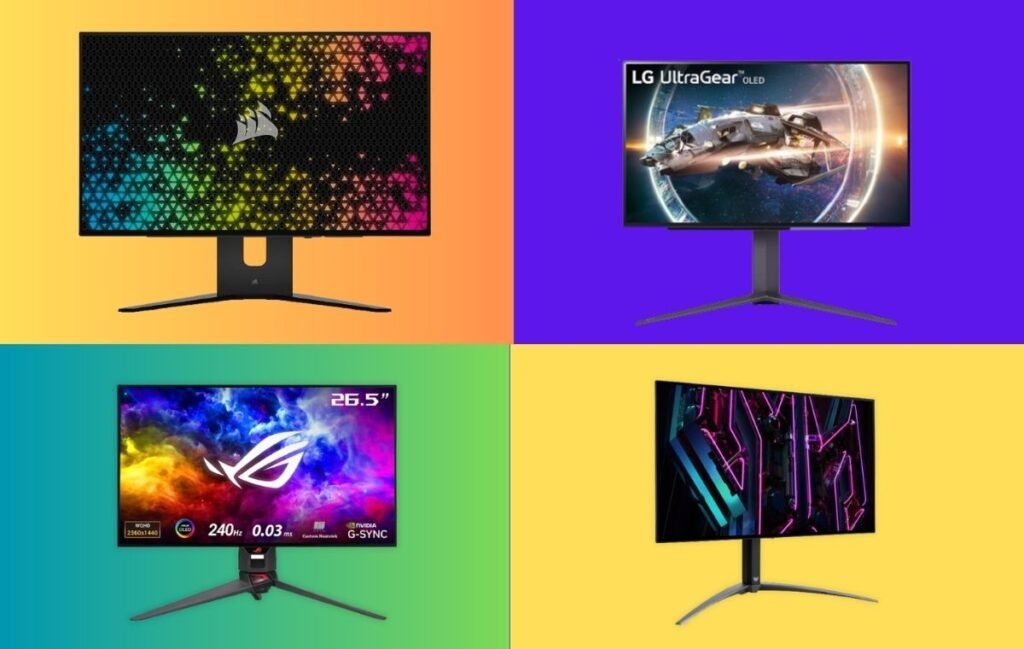Comparing four 27-inch 1440p 240Hz OLED gaming monitors to help you find the best option that suits your needs. The contenders in this showdown are the LG 27GR95QE, Asus ROG Swift OLED PG27AQDM, Corsair Xeneon 27QHD240, and Acer Predator X27U. I’ve conducted thorough testing on all four monitors, and I’ll be providing a detailed and in-depth analysis of how they stack up against each other.
Specifications

All four of these gaming monitors feature the same LG Display WOLED panel, measuring 27 inches with a sharp 2560 by 1440 resolution. They share a common trait of running at a maximum refresh rate of 240Hz and offer support for adaptive sync technologies. Some are marketed as FreeSync, others as G-Sync Compatible, and a few have both. However, the good news is that you’ll experience seamless variable refresh rate support on all these monitors, regardless of whether you’re using an AMD or Nvidia graphics card. The distinction between FreeSync and G-Sync has minimal impact on the performance of these current-generation monitors.
Design and Build Quality
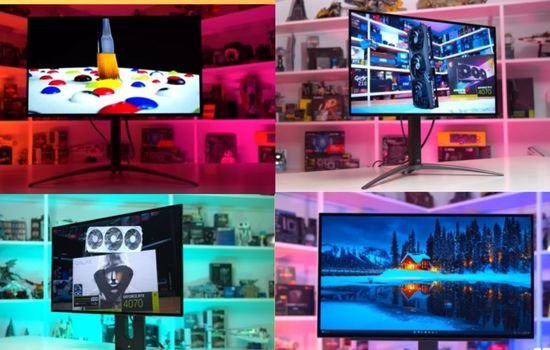
Each of the four versions boasts a unique design, though they share a similar overall template with distinctions like the stand, which aligns with the design language of the respective company. When it comes to the display itself, you’ll find that all four models sport nearly identical bezel sizes on all edges. This means that the part of the monitor you’ll be looking at most frequently is practically the same, regardless of the specific variant you choose. Moving to the back of each monitor, they all feature what I like to call the central box design. In this design, a central section houses all the display processing hardware, with the slim OLED panel extending from it. This consistent design element gives all four models a sleek and slim appearance along the edges.
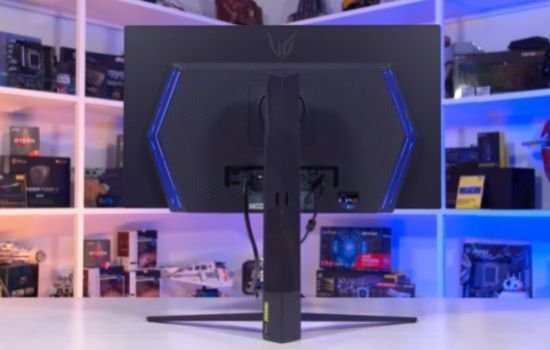
When it comes to aesthetics, it’s all about personal taste. These well-constructed models primarily use dark plastic in their designs. LG and Asus add a touch of flair with RGB LED lighting on the back, while Corsair and Acer keep it more understated. Regardless of your preference, you’re getting a visually pleasing monitor in any case. The stands share a similar appearance and functionality, offering height, tilt, swivel, and pivot adjustments. However, some designs may offer more practicality than others. LG and Corsair models have ports that are easy to access as they protrude directly from the rear panel. In contrast, Asus and Acer models have ports that point downward. It’s a minor detail, but I personally find LG and Corsair’s approach to be more convenient.
Ports and Connectivity

The selection of ports varies among the four models. All of them come equipped with DisplayPort 1.4 with DSC, ensuring a full 1440p 240Hz experience. Additionally, each of the four monitors has two HDMI ports. However, the LG model stands out with its full HDMI 2.1 support, boasting 48-gigabit-per-second ports that provide uninterrupted 1440p 240Hz output. Following closely is the Corsair model with 24-gigabit-per-second HDMI 2.1, which offers a similar experience to the LG for PC users but may be slightly less compatible with other devices. On the other hand, the Acer and Asus models are somewhat disappointing as they only feature HDMI 2.0, limiting the HDMI ports to 144Hz instead of the full 240Hz.
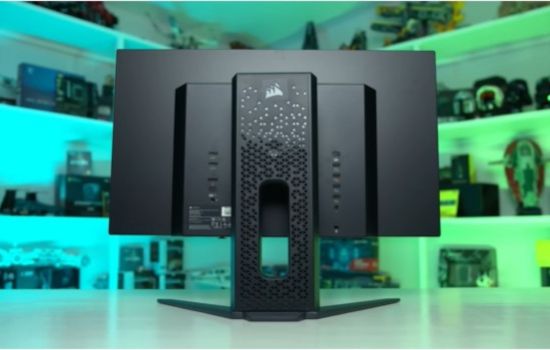
There are also differences in USB connectivity among these monitors. Corsair and Acer stand out by offering USB-C inputs with DP Alt Mode. Corsair provides 65 watts of power delivery, while Acer offers 90 watts, making both models suitable for single-cable laptop usage. Corsair also leads in the USB department with four USB-A ports, the highest among all models. The other three models feature only two USB Type-A ports. Additionally, Corsair and Acer go a step further by including a KVM switch, a feature that LG and Asus models do not offer.
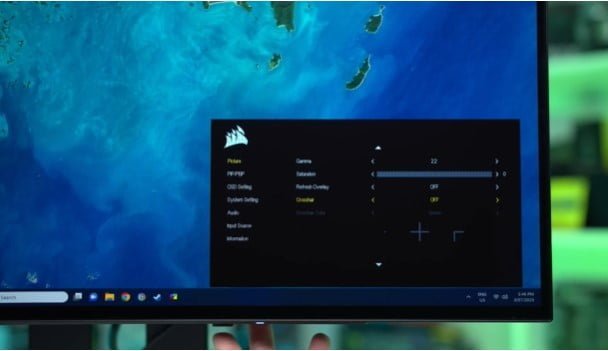
Three out of the four models (Acer, Corsair, and Asus) use a directional toggle for controlling the on-screen display (OSD), while the LG model opts for a user-friendly remote with controls right on the display housing. The Corsair variant also comes with a handy proximity sensor that displays an on-screen guide, simplifying the location of OSD controls. When it comes to OSD features, there isn’t a significant standout; the range of gaming features is quite similar across all models, with some variations in color controls that I’ll delve into further in this comparison.
Screen Coating, Subpixel Layout and Burn In

All four models use the same panel, which includes a matte anti-glare coating. Currently, glossy variants are not available on the market. However, the matte finish does an excellent job of reducing mirror-like reflections in brighter environments while maintaining black levels in other situations. It does have a slightly heavier texture, which may not be to everyone’s liking, but this finish is consistent across all models. So, if you choose this overall hardware package, you’ll have this finish.
Likewise, the RBGW subpixel layout is uniform across all models. Due to this consistent layout, text rendering appears the same on all four models. However, none of these monitors particularly excel in terms of text clarity. Additionally, because they use OLED technology, all models are susceptible to permanent burn-in. As a result, none of these variants are highly recommended for productivity tasks that involve extended periods of static content on the screen. However, they all perform admirably for content consumption, where subpixel layout and burn-in concerns are not an issue.
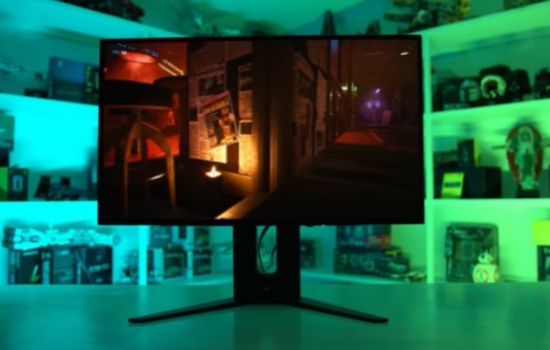
It’s worth mentioning that Corsair is the sole company offering a burn-in warranty for their unit. In contrast, LG, Asus, and Acer have decided not to include burn-in coverage in their warranties. So, if you’re particularly concerned about burn-in and want that extra peace of mind, Corsair is the brand that provides that assurance.
Response Time Performance
| LG 27GR95QE (27″ 1440p 240Hz WOLED) | 2.8% 0.20 |
| Asus ROG Swift OLED PG27AQDM (27″ 1440p 240Hz WOLED) | 0.7% 0.27 |
| Acer Predator X27U (27″ 1440p 240Hz WOLED) | 0.7% 0.27 |
| Corsair Xeneon 27QHD240 (27″ 1440p 240Hz WOLED) | 0.0% 0.35 |
When it comes to motion performance, there’s little difference among these four OLED monitors due to their shared panel. If you’re interested in response times and motion clarity, you’ll find minimal distinction between these models. The LG variant has a slightly higher level of overshoot than the other three, but this difference is hardly noticeable except in situations of lower refresh rate gaming. The Corsair, Acer, and Asus models all deliver practically identical performance, ensuring an exceptional 240Hz refresh rate gaming experience. In simple terms, speed won’t be a major factor in your decision when choosing between these four variants.
| Monitor | Maximum Refresh Rate, Adaptive Sync On, SDR Mode |
|---|---|
| Asus ROG Swift OLED PG27AQDM (27″ 1440p 240Hz WOLED) | 0.1 | 2.2 | 2.4 |
| Acer Predator X27U (27″ 1440p 240Hz WOLED) | 0.1 | 2.2 | 2.5 |
| Corsair Xeneon 27QHD240 (27″ 1440p 240Hz WOLED) | 0.2 | 2.3 | 2.5 |
| LG 27GR95QE (27″ 1440p 240Hz WOLED) | 0.3 | 2.4 | 2.5 |
When it comes to motion performance, there’s little difference among these four OLED monitors due to their shared panel. If you’re interested in response times and motion clarity, you’ll find minimal distinction between these models. The LG variant has a slightly higher level of overshoot than the other three, but this difference is hardly noticeable except in situations of lower refresh rate gaming. The Corsair, Acer, and Asus models all deliver practically identical performance, ensuring an exceptional 240Hz refresh rate gaming experience. In simple terms, speed won’t be a major factor in your decision when choosing between these four variants.
Color Performance
| Monitor | Peak Gamut Coverage Measured (CIE1976) |
|---|---|
| LG 27GR95QE (27″ 1440p 240Hz WOLED) | 72.9 |
| Acer Predator X27U (27″ 1440p 240Hz WOLED) | 72.8 |
| Corsair Xeneon 27QHD240 (27″ 1440p 240Hz WOLED) | 72.1 |
| Asus ROG Swift OLED PG27AQDM (27″ 1440p 240Hz WOLED) | 72.1 |
In terms of color quality, since all of them utilize the same WOLED panel, they offer identical color space coverage, which is approximately 97% DCI-P3 and about 72% Rec. 2020. There are no differences in color space coverage among these models. However, variations do arise when it comes to factory calibration. Out of the box, without any adjustments, the Acer and Corsair models notably exhibit better grayscale accuracy compared to the LG and Asus models. The latter two models tend to display a noticeable blue or cold tint. In contrast, the Acer and Corsair models approach the accurate 6500K point, resulting in improved Delta E values for SDR sRGB content. This difference also has a minor impact on saturation, although none of the four models come with an sRGB clamp enabled by default, resulting in similar oversaturation levels.
All four models feature an sRGB mode for grayscale, with the Corsair 27 QHD240 leading in terms of Delta E values. It’s followed by the Acer, LG, and Asus models, which perform similarly. When it comes to Color Checker evaluations, the Acer model slightly outperforms the Corsair, followed by the Asus variant, and then the LG model. If your intention is to use these monitors for SDR desktop tasks, the Corsair and Acer models stand out as the preferred choices, with a slight preference for the Corsair model.
However, it’s worth noting that all four models can be calibrated using software, resulting in highly similar results. The LG model has an advantage in this regard, as it also supports hardware calibration through its PC app. However, the results from this approach aren’t as effective as proper software calibration and require additional hardware. Nonetheless, it’s a unique feature supported by the LG model.
Brightness, Contrast, and Uniformity
| Monitor | Calibrated, SDR Mode, Max Brightness at 100% White |
|---|---|
| Asus ROG Swift OLED PG27AQDM (27″ 1440p 240Hz WOLED) | 243 |
| LG 27GR95QE (27″ 1440p 240Hz WOLED) | 198 |
| Acer Predator X27U (27″ 1440p 240Hz WOLED) | 136 |
| Corsair Xeneon 27QHD240 (27″ 1440p 240Hz WOLED) | 131 |
One of the primary differences among these four models lies in their brightness levels, particularly noticeable when considering SDR (Standard Dynamic Range) brightness. The Asus PG27AQDM emerges as the top choice for desktop applications in brighter environments, capable of reaching a peak brightness of 240 nits. While not exceptionally high, it surpasses the LG model by approximately 23%, which achieves 198 nits. In terms of brightness, the Acer and Corsair units fall significantly short, offering only 130 to 140 nits, making them less suitable for users who prefer a brighter display.
This concern is exacerbated by the absence of an option to disable the automatic brightness limiter (ABL). As a result, brightness constantly fluctuates as you move around or resize desktop applications, which can be quite frustrating. However, on the Corsair and Asus models, there’s a setting known as ‘uniform brightness’ or something similar that can be activated to disable this behavior and maintain consistent brightness levels as shown in the chart. On the other hand, the LG model lacks any ABL but permanently limits SDR brightness to roughly 200 nits.
For those using their monitors in dimly lit environments, the Acer and LG models are ideal choices. The Asus and Corsair models also offer respectable results, though not as impressive in this context. All four models excel in producing true black levels due to their use of OLED technology, resulting in an effectively infinite contrast ratio. Additionally, they all provide excellent viewing angles.
When it comes to uniformity, there are minimal differences among the various panels. In my experience, the Asus model exhibited slightly superior uniformity, but the variance was minor compared to the other models. Similarly, all four models share the same issue with gray uniformity, where dark gray tones may appear slightly uneven or ‘dirty.’ Unfortunately, this problem is not unique to a single variant; it affects all of them.
HDR Performance
In terms of HDR performance, all units exhibit the same inherent OLED qualities, such as per-pixel or local dimming, true black levels, precise control over bright and dark regions, and excellent shadow detail. These attributes hold true across all four models. However, significant differences arise in HDR accuracy and brightness, which are worth exploring.
To begin with, only the LG and Asus models accurately adhere to the HDR10 PQ EOTF curve. As seen in both these models, the measured gray performance line aligns perfectly with the expected curve represented by the yellow line. The Acer model displays elevated brightness for certain segments of its curve, while the Corsair model exhibits both raised and lowered sections. If your goal is to display HDR content with the highest accuracy on your screen (bearing in mind that calibrating HDR is notably more challenging than SDR), the LG and Asus models are the top choices.
Moreover, there are variations in HDR brightness. Similar to SDR content, the Asus model shines as the brightest in HDR, reaching up to 196 nits for full-screen Windows. Conversely, the other three models hover around 140 nits, giving the Asus model a 40-nit advantage. This distinction also holds for 10-window brightness, where the Asus model reaches 906 nits compared to approximately 665 nits for both the LG and Corsair models, and 633 nits for the Acer variant. Consequently, the Asus model significantly outshines its competitors in terms of HDR brightness.
This discrepancy becomes evident when examining brightness versus window size. This brightness advantage isn’t solely apparent in synthetic tests; it’s also observable during gaming. In a real-world gaming scene, I recorded a peak brightness of 850 nits on the Asus model compared to 616 nits on the Corsair, 591 nits on the Acer, and 585 nits on the LG model. Once again, the Asus model boasts around a 40% brightness advantage.
Although the Asus model isn’t consistently brighter in all scenarios, it generally holds this advantage in our real-world testing. Some models exhibit certain peculiarities in HDR performance. For instance, when transitioning between SDR and HDR modes, the Acer model necessitates adjusting a setting in the OSD every time. Ideally, these settings should switch automatically for the optimal experience. If you’re using the uniform brightness setting with the Corsair model, you must manually disable it when switching to HDR mode, repeating the process each time. Similarly, both the LG and Asus models require firmware updates for optimal HDR performance. Fortunately, all four variants support firmware updates, so it’s possible that some of these issues, particularly those affecting the Acer and Corsair models, could be addressed in future updates.
Final Thoughts
After thoroughly examining all four 27-inch 1440p 240Hz OLED gaming monitors, it’s clear that there are only a few distinctions between each unit. This is to be anticipated, considering they all employ the same LG Display WOLED panel. Yet, these differences are substantial enough to allow for a conclusive evaluation of the best model, at least in my view. Here’s how I would rank these models from least to best:
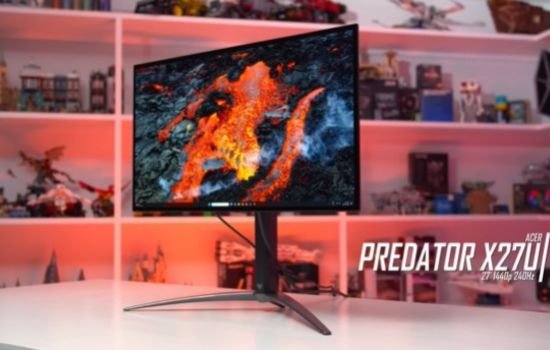
In last place is the Acer Predator X27U. It boasts the lowest peak brightness among the tested models, exhibits less accurate HDR presentation, and suffers from bothersome firmware quirks like the inability to disable the automatic brightness limiter and challenges in switching between HDR and SDR modes. Priced at $1000 USD, it’s also on the higher end in terms of cost. Although Acer has some notable features, like 90 watts of USB-C power delivery (making it laptop-friendly) and a well-calibrated sRGB mode, these aspects alone are insufficient to warrant a recommendation from me.
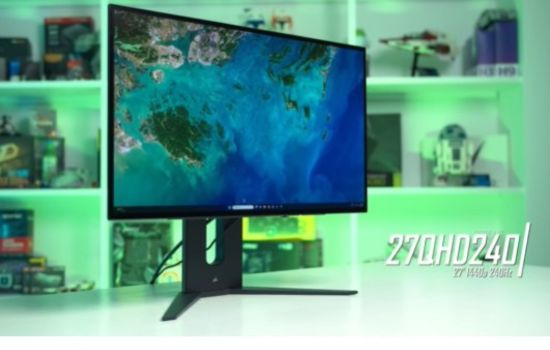
In third position, I place the Corsair Xeneon 27QHD240. Its brightness aligns with that of the Acer model, indicating a lackluster performance. Similarly, it faces challenges with HDR accuracy. However, it is less burdened by firmware issues, and the automatic brightness limiter can be deactivated. In terms of ports, it’s the most well-equipped, featuring HDMI 2.1, USB-C with 65 watts of power delivery, and a four-port USB hub. Its SDR factory calibration is also impressive, surpassing the LG and Asus models. Notably, Corsair distinguishes itself by offering burn-in coverage with their warranty. Priced at $999 USD, the Corsair model is worth considering, though I can’t rank it higher.
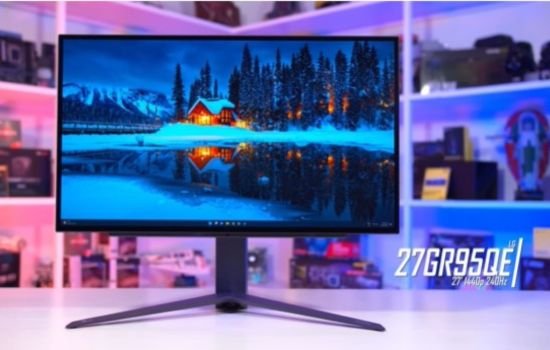
In second place, I have the LG 27GR95Q8, which only slightly surpasses the Corsair model. It offers superior SDR brightness and better HDR accuracy. It’s the sole model with full bandwidth 48 gigabits per second HDMI 2.1 ports and Hardware calibration support. Competitively priced at around $900 USD, with occasional sales dropping it to $800, it’s an enticing choice. However, certain trade-offs prevent it from ranking higher. For example, its SDR mode calibration falls behind the Corsair and Acer variants, and it lacks USB-C input or a KVM switch. It also exhibits slightly more overshoot at lower refresh rates, and its overall brightness lags behind the Asus model.
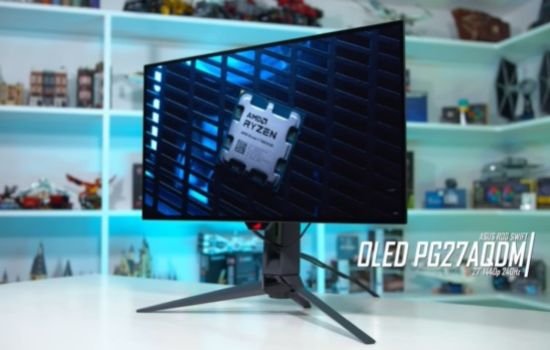
At the top spot, I name the Asus ROG Swift OLED PG27AQDM. The key factor influencing this decision is its significantly higher SDR and HDR brightness, combined with excellent HDR accuracy post a firmware update. Typically 30% to 40% brighter, this model’s OLED advantage provides a distinct edge. While this extra brightness could contribute to faster panel degradation, I don’t foresee it being a major issue for gaming or content consumption. Notably, Asus doesn’t include burn-in coverage in their warranty, which is disappointing. Despite this, the Asus model doesn’t exhibit any significant issues that would deter me from recommending it. Its SDR and HDR brightness advantages, combined with solid HDR accuracy, place it at the forefront of this comparison. However, it’s worth considering the $1000 USD price tag and weighing it against the LG model’s competitive pricing.
After thorough evaluation, the Asus ROG Swift OLED PG27AQDM emerges as the winner in my opinion. Its superior brightness and HDR accuracy set it apart, despite the trade-offs. Ultimately, your decision should consider the price difference, additional features, and specific requirements you have for a gaming monitor. You can also explore individual reviews for more detailed insights on each product.

